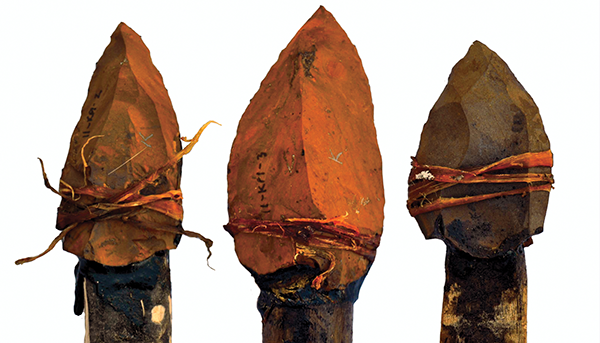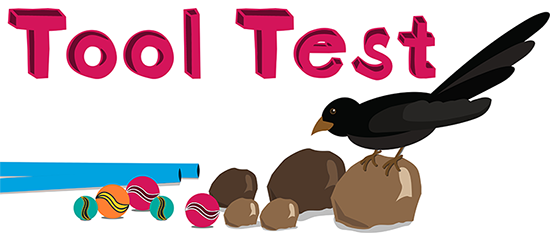
Tool test
Before you begin
We know that for millions of years, humans have evolved a whole suite of specialized skills to help us survive. Perhaps the most important of these skills was our ability to make and use tools. Tools enabled early humans to access new types of foods and eventually, to hunt for their prey.
What you will need
For the clay challenge
- Acrylic tube
- Modeling clay
- Assorted objects (buttons, small toys, beads)
- Assorted tools (tweezers, chop sticks, wire)
- Crow video (optional): https://youtu.be/TtmLVP0HvDg
- The experiment packet [PDF]
For the water challenge
- Acrylic tube
- Pitcher of water
- Floating objects (corks, small rubber duckies)
- Blocks (two material types, one dense and one buoyant)
- Crow video (optional): https://youtu.be/ZerUbHmuY04
- The experiment packet [PDF]
Procedures
Procedure for the clay challenge

A small object is stuck at the bottom of the tube. Can you get it out? You can use the tools any way you want, but you cannot tip the tube.
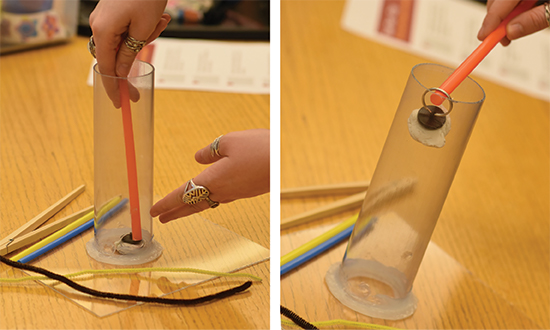
Hint: If you’re having trouble, try combining the tools or modifying them so they work better.

Now, your instructor will swap out the object in the tube for a new one, and give you a new set of tools to try this again.
When you’re done, watch the video to see how a New Caledonian Crow solved this problem.
Procedure for the water challenge
A small object is floating in water, out of reach. Can you figure out how to get it? You can use the objects in front of you, but you cannot tip the tube or reach your hands in.
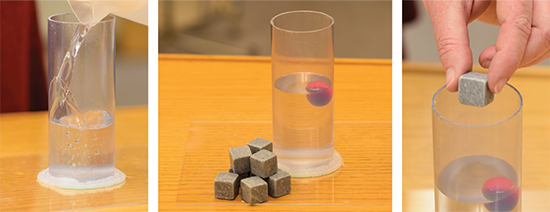
If you’re having trouble, think about Aesop’s Fable The Crow and the Pitcher. How does the crow in the story raise the water level to get a drink?
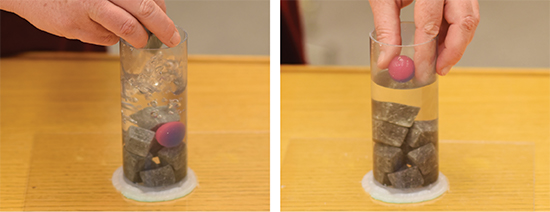
Watch the video to see how a New Caledonian crow solved this problem!
Learn more
Only a few animals use tools, and fewer still are able to solve complex problems. When you figured out how to get the object out of the tube, you demonstrated some of the traits that make us human. From drinking straws to airplanes, people make tools to address challenges big and small.
All animals rely on their bodies to survive, and their bodies are adapted to increase the odds of their survival. Butterflies have an organ called a proboscis (a feeding organ near the mouth that works like a straw), which they use to drink nectar, and they also use their wings to fly. Their bodies have adapted to the type of food and movement that they specialize in.
Some animals can use tools, and can be quite clever about problem-solving. For example, New Caledonian crows—the same species that you saw in the video—use twigs to get tasty beetle larvae out of dead trees, and chimpanzees use sticks to get ants out of anthills.
Humans use technologies to adapt to our physical environment. This allows people to live in every climate on Earth. Compared to other animals, people have more kinds of tools and our tools are more specialized. We also improve our tools over time, learning from what others have done.
Read more about human tool use here: https://askananthropologist.asu.edu/stories/chipping-away-tools-stone-age
Bibliographic Details
- Article: Tool test
- Author(s): Amy Peterson
- Publisher: Arizona State University Institute of Human Origins Ask An Anthropologist
- Site name: ASU - Ask An Anthropologist
- Date published:
- Date modified:
- Date accessed: December 17, 2025
- Link: https://askananthropologist.asu.edu/experiments/tool-test
APA Style
Amy Peterson. (). Tool test. Retrieved 2025, Dec 17, from {{ view_node }}
American Psychological Association, 6th ed., 2nd printing, 2009.
For more info, see the
APA citation guide.
Chicago Manual of Style
Amy Peterson. "Tool test." ASU - Ask An Anthropologist. Published . Last modified . https://askananthropologist.asu.edu/experiments/tool-test.
Chicago Manual of Style, 17th ed., 2017.
For more info, see the
Chicago Manual citation guide.
MLA Style
Amy Peterson. Tool test. ASU - Ask An Anthropologist. , {{ view_node }}. Accessed December 17, 2025.
Modern Language Association, 8th ed., 2016.
For more info, see the
MLA citation guide.
Experiment Packet
Be Part of
Ask An Anthropologist
By volunteering, or simply sending us feedback on the site. Scientists, teachers, writers, illustrators, and translators are all important to the program. If you are interested in helping with the website we have a volunteers page to get the process started.

